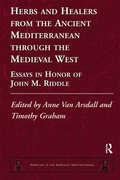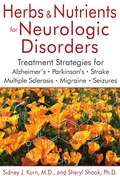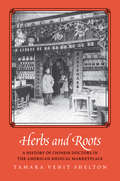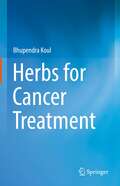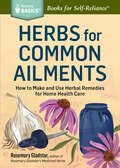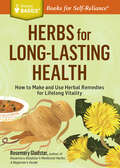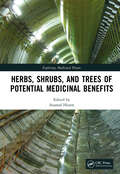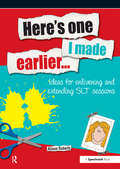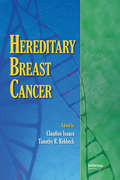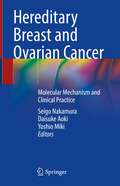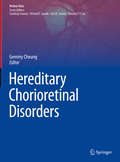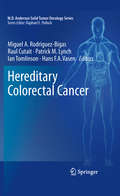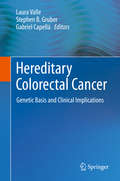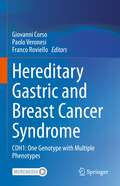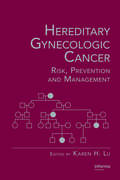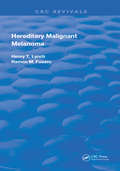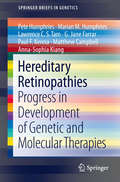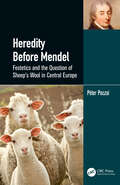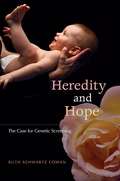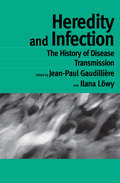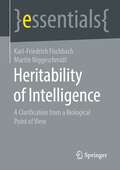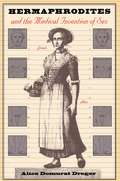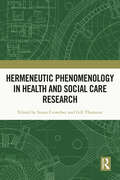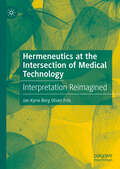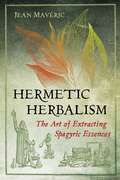- Table View
- List View
Herbs and Healers from the Ancient Mediterranean through the Medieval West: Essays in Honor of John M. Riddle (Medicine in the Medieval Mediterranean #4)
by Anne Van Arsdall Timothy GrahamHerbs and Healers from the Ancient Mediterranean through the Medieval West brings together eleven papers by leading scholars in ancient and medieval medicine and pharmacy. Fittingly, the volume honors Professor John M. Riddle, one of today's most respected medieval historians, whose career has been devoted to decoding the complexities of early medicine and pharmacy. "Herbs" in the title generally connotes drugs in ancient and medieval times; the essays here discuss interesting aspects of the challenges scholars face as they translate and interpret texts in several older languages. Some of the healers in the volume are named, such as Philotas of Amphissa, Gariopontus, and Constantine the African; many are anonymous and known only from their treatises on drugs and/or medicine. The volume's scope demonstrates the breadth of current research being undertaken in the field, examining both practical medical arts and medical theory from the ancient world into early modern times. It also includes a paper about a cutting-edge Internet-based system for ongoing academic collaboration. The essays in this volume reveal insightful research approaches and highlight new discoveries that will be of interest to the international academic community of classicists, medievalists, and early-modernists because of the scarcity of publications objectively evaluating long-lived traditions that have their origin in the world of the ancient Mediterranean.
Herbs and Nutrients for Neurologic Disorders: Treatment Strategies for Alzheimer’s, Parkinson’s, Stroke, Multiple Sclerosis, Migraine, and Seizures
by Sheryl Shook Sidney J. KurnA guide to herbal and holistic medicine for brain health and neurologic disorders• Provides detailed herbal, antioxidant, and nutritional strategies for Alzheimer’s, Parkinson’s, multiple sclerosis, stroke, migraine, and seizures• Supported by scientific studies and years of successful clinical practice• Discusses potential side effects, counter-indications, and the proper dosages to reduce symptoms, slow disease progression, and lessen the chances of recurrenceNumerous medical journals have published studies supporting the use of herbs and nutrients in the treatment of neurodegenerative disorders. Yet in practice most neurologists rarely include them as part of their protocols. In this practical guide, Sidney Kurn, M.D., and Sheryl Shook, Ph.D., explain how to safely and easily incorporate herbs, antioxidants, and nutritional supplements into the standard conventional treatments for 6 common neurologic disorders: Alzheimer’s, Parkinson’s, multiple sclerosis, stroke, migraine, and seizures.For each condition, the authors provide detailed strategies supported by scientific evidence and years of successful clinical practice. They examine the biochemical role of each recommended herb, nutrient, or antioxidant and discuss potential side effects, counter-indications, and proper dosages to reduce symptoms, slow disease progression, and--in the case of stroke, migraine, and seizures--lessen the chances of recurrence. The authors explore the nutrient deficiencies and physiological mechanisms, including inflammation, heavy metal toxicity, and mitochondrial dysfunction, that can cause oxidative injuries and initiate neurologic disorders. They reveal which common substances, such as aspartame and glutamate, can trigger these mechanisms at the cellular level and recommend specific herbs and antioxidants, such as turmeric, cannabinoids, resveratrol, and N-acetyl cysteine, to counteract their effects. They discuss the importance of sleep to overall well-being, especially for those suffering from neurologic disorders, and offer tips to help ensure a good night’s sleep.Integrating neuroscience, biochemistry, herbalism, and decades of clinical experience, the authors lay the scientific foundation for a holistic, naturopathic approach to neurologic disorders and a way to enhance the quality of life for those suffering from these conditions.
Herbs and Roots: A History of Chinese Doctors in the American Medical Marketplace
by Tamara Venit SheltonAn innovative, deeply researched history of Chinese medicine in America and the surprising interplay between Eastern and Western medical practice Chinese medicine has a long history in the United States, with written records dating back to the American colonial period. In this intricately crafted history, Tamara Venit Shelton chronicles the dynamic systems of knowledge, therapies, and materia medica crossing between China and the United States from the eighteenth century to the present. Chinese medicine, she argues, has played an important and often unacknowledged role in both facilitating and undermining the consolidation of medical authority among formally trained biomedical scientists in the United States. Practitioners of Chinese medicine, as racial embodiments of “irregular” medicine, became useful foils for Western physicians struggling to assert their superiority of practice. At the same time, Chinese doctors often embraced and successfully employed Orientalist stereotypes to sell their services to non-Chinese patients skeptical of modern biomedicine. What results is a story of racial constructions, immigration politics, cross-cultural medical history, and the lived experiences of Asian Americans in American history.
Herbs for Cancer Treatment
by Bhupendra KoulThis book provides detailed information on the various types of cancer, etiology, effects, and challenges associated with current cancer treatment regimes. The present edition has been written to reflect recent developments, success rates and lacunae in herbal and modern cancer therapies. It also describes the use of several herbal formulations to boost patients’ immunity, in order to prevent or help them cope with several cancers. The book highlights several herbs/shrubs/trees that have been reported to possess anti-cancer properties, paving the way for in-depth research into the dose standardization and efficacy of plant-based bioactive molecules. It also focuses on the sustainable conservation of medicinal flora, so that, in future, novel biomolecules be extracted and made available for the treatment of various cancers. Given its highly relevant content, the book will benefit the entire cancer research community (students, scientists, pharmacists, herbalists and lecturers) at universities, research institutions and industry in the areas of oncology, herbal cancer therapy, biotechnology, drug discovery, pharmaceuticals, agriculture, and various disciplines of the biomedical sciences.
Herbs for Common Ailments: How to Make and Use Herbal Remedies for Home Health Care. A Storey BASICS® Title (Storey Basics)
by Rosemary GladstarIn this Storey BASICS® guide, best-selling author and master herbalist Rosemary Gladstar shows you how to use 56 common herbs to safely address a wide range of everyday ailments. Covering everything from burns, wounds, and bruises to headaches, congestion, and insomnia, Gladstar offers dozens of easy-to-make recipes for herbal remedies that will soothe your woes without the harsh ingredients found in commercial pharmaceuticals. Keep your family happy, healthy, and safe with the natural healing power of herbs.
Herbs for Long-Lasting Health: How to Make and Use Herbal Remedies for Lifelong Vitality. A Storey BASICS® Title (Storey Basics)
by Rosemary GladstarRosemary Gladstar shows you how to enhance your well-being in middle age and beyond using herbal remedies that effectively and safely promote vitality. With in-depth profiles of 22 medicinal herbs, preparation instructions, and dosage guidelines, you’ll discover how you can use astragalus to regenerate your body’s immune system, bilberry to ease eye problems, and milk thistle to rebuild damaged liver cells. You’ll be amazed at how herbal treatments can help support your nervous system, activate your metabolism, and keep your bones and joints healthy.
Herbs, Shrubs, and Trees of Potential Medicinal Benefits (Exploring Medicinal Plants)
by Azamal HusenThere has been a worldwide increase in the demand for medicinal plants that aid the immune system, and considerable progress has been made in plant-based drug development. Herbs, Shrubs and Trees of Potential Medicinal Benefits examines how plants are used in the development of drugs preventing and treating cancer, hepatitis, asthma, influenza, HIV, and other diseases by manipulating a variety of bioactive molecules found in these plant parts. The book analyses how plants may strengthen human immunity, improve mood and brain function, enhance blood and oxygen circulation, boost the healing processes, and maintain blood pressure. Though many herbs, shrubs and trees have been identified for developing healthcare products, many of them require further exploration for potential usage. This volume in the Exploring Medicinal Plants series, presents information on herbs, shrubs and trees discussing traditional knowledge, chemical derivatives, and potential benefits of these items. Features: Identifies and highlights some medicinal herbs, shrubs and or trees around the world, presenting overall potential benefits to human health. Explores important medicinal plants for their bioactive constituents and phytochemicals. Discusses medicinal herbs, shrubs, and or trees for their uses in herbal drug preparation. Written by an international panel of plant scientists, this book is an essential resource to students, pharmacists, and chemists. It provides valuable information on fundamental chemical principles, modes of action, and product formulation of bioactive natural products derived from plants for medical applications.
Here's One I Made Earlier: Ideas for Enlivening and Extending SLT Sessions
by Alison RobertsThis imaginative and practical book contains a collection of ideas and games that should provide you with lots of new resources without spending a fortune. Some of the games and activities address particular communication themes, such as: listening techniques; speech sounds; vocabulary building; and friendship skills, while others cover several areas simultaneously. The book is organised into chapters according to the major skill area being addressed, with suggestion for linked items in other chapters. To add to well-established and structured programmes of therapy that SLTs use, there are two principles that can make for better therapeutic outcomes, and on which the book is based: clients often respond more effectively if they feel that they "own" their therapy by being involved in making the materials that they will use; and therapy is improved when it is good fun, and preferably humorous. You don't need to be a great artist or craftsman to create these games and activities, or huge quantities of spare time to make most of the items, especially if you can get organised with equipment all in one go. There is a basic shopping list to help you get started. It is a must have for all Speech and Language Therapists. It is presented in A4 wire-o-bound.
Hereditary Breast Cancer
by Claudine Isaacs Timothy R. RebbeckIntended for medical oncologists, surgeons, obstetricians, gynecologists, geneticists, genetic counselors, and primary care physicians, this text presents the epidemiological, biological, and clinical issues associated with hereditary breast cancer. It offers clear guidance on the application and utilization of cancer risk assessment models, geneti
Hereditary Breast and Ovarian Cancer: Molecular Mechanism and Clinical Practice
by Seigo Nakamura Daisuke Aoki Yoshio MikiThis highly informative and clearly written book presents the basic science and the latest data on hereditary breast and ovarian cancer (HBOC) to provide an up-to-date and holistic overview of the disease. It starts off by presenting the molecular mechanisms, genetic testing and counseling, and variants of unknown significance (VUS) to help readers understand the contemporary interpretation of the disease. Further chapters focus on the surveillance, diagnosis and treatment, including chemoprevention, risk reduction and drug development based on molecular mechanisms. It also includes a chapter on the latest findings from the HBOC database, ethical issues and the parp inhibitors, and discusses innovative thinking to manage and understand the disease. Hereditary Breast and Ovarian Cancer - Molecular Mechanism and Clinical Practice offers breast surgeons, medical oncologists, gynecological oncologists and genetic counselors a comprehensive overview of the disease. Providing insights into recent scientific findings and further avenues for investigation, it is also a thought-provoking and informative read for researchers and scholars.
Hereditary Chorioretinal Disorders (Retina Atlas)
by Gemmy CheungThis volume of the retina atlas focuses on hereditary chorioretinal disorders. The topics covered include retinitis pigmentosa, Best disease, congenital X-linked retinoschisis, cone dystrophy, Stargardt’s disease, pattern dystrophy, North Carolina macular dystrophy, choroideremia, Mallattia Leventinese, Bietti’s crystalline dystrophy, and albinism. All clinical features are clearly illustrated with multimodal imaging techniques. The utility of some of the latest imaging tools such as OCT angiography, adaptive optics-scanning laser ophthalmoscopy, and microperimetery is discussed. Readers will gain valuable new insights into pathogenesis at the molecular level, which have been facilitated by recent genetic discoveries. The use of genetic testing and the latest advances in and challenges of gene therapy and cell-based therapy are also covered in detail.Hereditary Chorioretinal Disorders atlas is one of nine volumes in the series Retina Atlas. The series provides validated and comprehensive information on vitreoretinal diseases, covering imaging basics, retinal vascular diseases, macular disorders, ocular inflammatory and infectious disorders, retinal degeneration, the surgical retina, ocular oncology, pediatric retina and trauma.
Hereditary Colorectal Cancer
by Ian Tomlinson Hans F.A. Vasen Miguel A. Rodriguez-Bigas Raul Cutait Patrick M. LynchColorectal cancer is the third most commonly diagnosed cancer in the US and the third most recently linked to cancer deaths. The national annual incidence rate of colorectal cancer is approximately 148,000+, striking slightly more females than males. The lifetime risk of colorectal cancer is 5-6%, however patients with a familial risk (with two or more first or second degree relatives) make up 20% of the patients. Persons who carry genetic mutations linked to hereditary colorectal cancer are the most likely to develop the disease.
Hereditary Colorectal Cancer: Genetic Basis And Clinical Implications
by Laura Valle Stephen B. Gruber Gabriel CapelláThis book provides information on a wide variety of issues ranging from genetics to clinical description of the syndromes, genetic testing and counseling, and clinical management including surveillance, surgical and prophylactic interventions, and chemoprevention. Moreover, current hot issues, such as the identification of novel causal genes and the challenges we face, and the relevance of cancer risk modifiers, both genetic and environmental, are also discussed. This reference book is great for geneticists, oncologists, genetic counselors, researchers, clinicians, surgeons and nurses dedicated to, or interested in, hereditary cancer. The best and most recognized experts in the field have contributed to this project, guaranteeing updated information, accuracy and the discussion of topical issues.
Hereditary Gastric and Breast Cancer Syndrome: CDH1: One Genotype with Multiple Phenotypes
by Franco Roviello Giovanni Corso Paolo VeronesiIn this book the editors and authors provide a comprehensive overview on basic research and clinical aspects of hereditary breast and gastric tumors. In particular, this updated editorial work aims to suggest guidelines for the clinical management of patients with hereditary diffuse gastric and lobular breast cancer. Special attention is given to E-cadherin (CDH1 gene) germline mutations, genetic screening approaches, the underlying molecular mechanisms and pathological and microscopic features. In addition, the book aims to define clinical criteria for genetic screening, and highlights current surgical treatment and clinical approaches for asymptomatic mutation carriers. Other inherited predispositions involving gastric and breast carcinoma are discussed as well. Divided into eight sections, the book starts by providing an epidemiological overview of gastric and breast cancers, followed by a section dealing with new descriptions of genetic pathways in hereditary cancer predispositions. The third section focuses on pathological features of the diseases, in an effort to bridge the gap between discovery and cancer therapy development. Subsequent sections of the book are dedicated to endoscopy and breast imaging, as well as risk-reducing surgeries to curb the risk of developing cancer. The sixth section focuses on the generation of ideas for the identification of targets and novel treatment strategies. Finally, in the seventh section the authors share the story of two patients and their experiences with the diagnosis and treatment of hereditary cancer.This multidisciplinary book brings together multiple disciplines in science and technology; specifically, medicine, surgery and biology. The majority of authors are members of the International Gastric Cancer Linkage Consortium (IGCLC) and of the European Cancer Prevention Organization (EJCPO), with relevant experience in this context. Offering in-depth insights into hereditary cancers, this book represents essential reading for students, researchers, and specialists who want to extend their knowledge on hereditary gastric and breast cancers.
Hereditary Gynecologic Cancer: Risk, Prevention and Management
by Karen H. LuHereditary Gynecologic Cancer: Risk, Prevention and Management fills the need that exists for a book addressing highly relevant clinical issues associated with the new field of hereditary gynecologic cancers. Written with the clinician in mind, the authors will cover a broad range of topics, beginning with an overview discussing clinical relevance
Hereditary Malignant Melanoma (Routledge Revivals)
by Henry T. Lynch Ramon M. FusaroFirst published in 1991: The book focuses only on hereditary malignant melanoma. The epidemic of cutaneous melanoma which is now occurring in the sun belt areas of the world is due partly to a susceptible subgroup of Caucasians who have immigrated there.
Hereditary Retinopathies
by Matthew Campbell G. Jane Farrar Lawrence C. Tam Marian M. Humphries Pete Humphries Anna-Sophia Kiang Paul F. KennaThe hereditary retinopathy, retinitis pigmentosa (RP), which affects 1 in 3,500 people worldwide, is the most common cause of registered visual handicap among those of the working age in developed countries. RP is a highly variable disorder where patients may develop symptomatic visual loss in early childhood, while others may remain asymptomatic until mid-adulthood. Most cases of RP segregate in autosomal dominant, recessive or X-linked recessive modes, with approximately 41 genes being implicated in disease pathology to date (RetNet). The extensive genetic heterogeneity associated with autosomal dominant RP (adRP) is an undisputed hindrance to the development of genetically based therapeutics.
Heredity Before Mendel: Festetics and the Question of Sheep's Wool in Central Europe
by Péter PoczaiThe history of Science is replete with untold stories and this book is one of these accounts. The author shares a narrative of heredity, an active topic of inquiry long before Gregor Mendel – the father of genetics – planted his peas. One such interlude unfolded in Mendel’s home city and involved the sheep breeder, Imre Festetics. He sought to improve wool and proposed important rules of heredity. Unfortunately, aspects of wool quality, now known to be polygenic, complicate interpretations of the work of Festetics and explain why it is neglected. The forebearers of Mendel never get the credit they deserve. Heredity Before Mendel resurrects Festetics, the grandfather of heredity. Key Features 1) Documents a vibrant community of scholars interested in heredity before Mendel 2) Highlights the work of Imre Festetics, the forgotten grandfather of genetics 3) Desribes political repression which stifled the nascent foundation of heredity research 4) Emphasizes the role sheep and wool played as the first model system of genetics 5) Challenges19th century taboos in Moravia leading to malicious rumors about the inbred royal House of Austria (Habsburgs).
Heredity and Hope: The Case for Genetic Screening
by Ruth Schwartz CowanThe secrets locked in our genes are being revealed, and we find ourselves both enthused and frightened about what that portends. We look forward to curing disease and alleviating suffering--for our children as well as for ourselves--but we also worry about delving too deeply into the double helix. Abuses perpetrated by eugenicists--from involuntary sterilization to murder--continue to taint our feelings about genetic screening. Yet, as Ruth Schwartz Cowan reveals, modern genetic screening has been practiced since 1960, benefiting millions of women and children all over the world. She persuasively argues that new forms of screening--prenatal, newborn, and carrier testing--are both morally right and politically acceptable. Medical genetics, built on the desire of parents and physicians to reduce suffering and increase personal freedom, not on the desire to "improve the human race," is in fact an entirely different enterprise from eugenics. Cowan's narrative moves from an account of the interwoven histories of genetics and eugenics in the first half of the twentieth century, to the development of new forms of genetic screening after mid-century. It includes illuminating chapters on the often misunderstood testing programs for sickle cell anemia, and on the world's only mandated premarital screening programs, both of them on the island of Cyprus. Neither minimizing the difficulty of the choices that modern genetics has created for us nor fearing them, Cowan bravely and compassionately argues that we can improve the quality of our own lives and the lives of our children by using the modern science and technology of genetic screening responsibly.
Heredity and Infection: The History of Disease Transmission (Routledge Studies in the History of Science, Technology and Medicine)
by Jean-Paul Gaudillière Ilana LöwyIdeas about the transmission of disease have long formed the core of modern biology and medicine. Heredity and Infection examines their development over the last century. Two scientific revolutions - the bacteriological revolution of the 1890s and the genetic revolution at the start of the twentieth century - acted as the catalysts of major change in our understanding of the causes of illness. As well as being great scientific achievements, these were social and political watersheds that reconfigured the medical and administrative means of intervention. By establishing a clear distinction between transmission by infection and genetic transmission, this shift was instrumental in separating hygiene from eugenism. The authors argue that the popular perception of such a sharp divide stabilized only after 1945 when the use of antibiotics to end epidemics became commonplace. For health professionals the separation has never become an absolute one, and the book examines the various blends of heredity and infection that have preoccupied biology, medicine and the social sciences. Heredity and Infection recontructs the changing epidemiology of such historically important pathologies as tuberculosis , cancer and AIDS. In doing so, it demonstrates the role of experimental models, medical practices and cultural images in the making of contemporary biochemical knowledge.
Heritability of Intelligence: A Clarification From a Biological Point of View (essentials)
by Karl-Friedrich Fischbach Martin NiggeschmidtIs intelligence heritable? Karl-Friedrich Fischbach and Martin Niggeschmidt show that "heritability" means something different in biological terminology than in everyday language - which almost inevitably leads to misinterpretations. They explain why twin studies are controversial - and why genetic predictions of IQ and "educational attainment" must be treated with skepticism. This book is a translation of the original German 2nd edition Erblichkeit der Intelligenz by Karl-Friedrich Fischbach & Martin Niggeschmidt, published by Springer Fachmedien Wiesbaden GmbH, part of Springer Nature in 2019. The translation was done with the help of artificial intelligence (machine translation by the service DeepL.com). A subsequent human revision was done primarily in terms of content, so that the book will read stylistically differently from a conventional translation. Springer Nature works continuously to further the development of tools for the production of books and on the related technologies to support the authors.The Authors:Prof. Dr. Karl-Friedrich Fischbach is a developmental biologist and neurogeneticist. He was professor of biophysics and molecular biology at the University of Freiburg from 1985 to 2013, including two years as executive director of the Institute of Biology III. Martin Niggeschmidt is an editor in Hamburg.
Hermaphrodites and the Medical Invention of Sex
by Alice Domurat DregerPunctuated with remarkable case studies, this book explores extraordinary encounters between hermaphrodites--people born with "ambiguous" sexual anatomy--and the medical and scientific professionals who grappled with them. Alice Dreger focuses on events in France and Britain in the late nineteenth century, a moment of great tension for questions of sex roles. While feminists, homosexuals, and anthropological explorers openly questioned the natures and purposes of the two sexes, anatomical hermaphrodites suggested a deeper question: just how many human sexes are there? Ultimately hermaphrodites led doctors and scientists to another surprisingly difficult question: what is sex, really? Hermaphrodites and the Medical Invention of Sex takes us inside the doctors' chambers to see how and why medical and scientific men constructed sex, gender, and sexuality as they did, and especially how the material conformation of hermaphroditic bodies--when combined with social exigencies--forced peculiar constructions. Throughout the book Dreger indicates how this history can help us to understand present-day conceptualizations of sex, gender, and sexuality. This leads to an epilogue, where the author discusses and questions the protocols employed today in the treatment of intersexuals (people born hermaphroditic). Given the history she has recounted, should these protocols be reconsidered and revised? A meticulously researched account of a fascinating problem in the history of medicine, this book will compel the attention of historians, physicians, medical ethicists, intersexuals themselves, and anyone interested in the meanings and foundations of sexual identity.
Hermeneutic Phenomenology in Health and Social Care Research
by Susan Crowther Gill ThomsonThis book explores how, why, and when hermeneutic phenomenology can be used as methodology in health and social research. Providing actual examples of doing robust hermeneutic phenomenology and a focus on praxis, the book demonstrates how philosophical or theoretical notions can inform, enrich and enhance our research projects. The chapters offer examples of many different research designs and interpretive decisions in order to illustrate the unbounded and creative nature of this type of inquiry, whilst also demonstrating the trustworthiness of the scientific processes adopted. The chapter authors invite the reader on a unique journey that highlights how they made individual and tailored decisions throughout their projects, emphasising the challenges and joys they encountered. This book is a valuable resource for all students and academics who wish to explore the meaningfulness of human lived experiences across the multitude of phenomena in health and social care.
Hermeneutics at the Intersection of Medical Technology: Interpretation Reimagined
by Jan Kyrre FriisThis book explores the crucial role of interpretation in medical radiology and beyond, emphasizing its pervasive influence on medical knowledge. Friis examines radiological analysis through hermeneutics, cognition, and visual perception studies. He argues that interpretation is inherently embodied and essential to human action, particularly in radiology, where technology extends vision beyond the human eye&’s limits. Yet, interpretation varies among radiologists. Can it be too relative, shaped by subjective factors irrelevant to the task? Attempts to eliminate cognitive bias through psychophysical and cognitivist approaches have failed. Interpretation is an active, context-dependent process, inseparable from human experience. Friis contends that the only solution is to expand cognitive reach through collaborative interpretative practices, integrating diverse perspectives. Radiology, like all medical fields, benefits from shared expertise, where multiple viewpoints refine diagnostic accuracy and mitigate individual bias. By fostering structured cooperation among radiologists, clinicians, interpretative reliability can be strengthened. The key is not to eliminate subjectivity but to harness it constructively through interdisciplinary dialogue, collective reasoning, and continuous knowledge exchange.
Hermetic Herbalism: The Art of Extracting Spagyric Essences
by Jean MavéricA never-before-translated occult classic that brings the science of herbal medicine back to its Hermetic roots • Includes a large collection of recipes for spagyric medicines and quintessences, with detailed step-by-step instructions, adapted from celebrated spagyrists such as Paracelsus, Pseudo-Lull, Philipp Ulstad, and Nicaise Le Fèvre • Provides botanical and medicinal classifications of over 600 plant species along with their astral natures, elemental qualities, and planetary and zodiacal signatures • Explores advanced methods and techniques and shares the author&’s secret formula for a universal circulatum First published in French in 1911, this practical guide to the art of spagyrics begins by outlining the ancient yet often forgotten Hermetic foundations of herbalism. Author Jean Mavéric provides botanical and medicinal classifications of over 600 plant species along with an in-depth study of their astral natures, elemental qualities, and planetary and zodiacal signatures as well as practical advice on the appropriate times to harvest plants and administer herbal remedies and quintessences. Reviewing the general principles and procedures of premodern chemistry, Mavéric then explores the secret doctrines and operations of the spagyric art. He offers a large collection of recipes for spagyric herbal preparations adapted from celebrated spagyrists such as Paracelsus, Pseudo-Lull, Philipp Ulstad, Jan Baptist van Helmont, Oswald Croll, and Nicaise Le Fèvre, providing detailed step-by-step instructions for a veritable pharmacopeia of spagyric extracts, tinctures, elixirs, liquors, oils, unguents, salts, aquae vitae, and quintessences. Mavéric also shares his intricate theory of astral medicine and advocates a seasonal &“Hermetic diet&” designed to keep the humors of the body in equilibrium and prevent the onset of illness. In the final section of the book, Mavéric focuses on the more advanced methods and techniques of Paracelsus, Helmont, and George Starkey, unraveling the mysteries of manufacturing alkalis, alkahests, and menstrua and divulging his own secret formula for a universal circulatum. Available now for the first time in English, this occult classic unveils the art of extracting spagyric essences to a modern audience while also bringing the science of herbal medicine back to its Hermetic roots.
